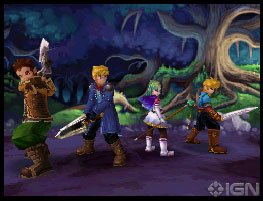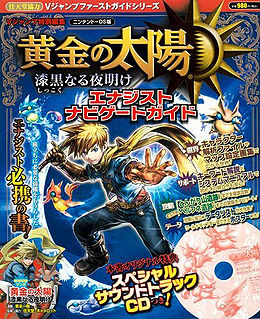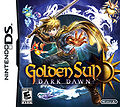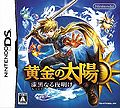Golden Sun: Dark Dawn
| Golden Sun: Dark Dawn | |
|---|---|

| |
| Developer(s) | Camelot Software Planning |
| Publisher(s) | Nintendo |
| Producer(s) | Takahashi Brothers |
| Composer(s) | Motoi Sakuraba |
| Series | Golden Sun |
| Platform | Nintendo DS |
| Release Date | Japan: 28 October 2010 North America: 29 November 2010 Australia: 2 December 2010 Europe: 10 December 2010 |
| Genre | Hand-held role-playing game |
| Ratings | CERO=A ESRB=E10+ PEGI=12+ |
| Media | Nintendo DS cartridge |
Golden Sun: Dark Dawn (黄金の太陽 漆黒なる夜明け, Ōgon no Taiyō: Shikkokunaru Yoake) is the third game in the Golden Sun series. Originally shown as "Golden Sun DS," the game was revealed to have the subtitle "Dark Dawn" on June 15, 2010. It was released on the Nintendo DS platform and is a continuation of the story started in Golden Sun and Golden Sun: The Lost Age.
The game picks up 30 years after the end of The Lost Age, and follows Matthew, Tyrell, and Karis on their journey across Weyard in it's modern state. They pick up many traveling companions throughout their journey, and begin to solve the mysteries that their parents created when they unleashed the power of Alchemy 30 years ago.
Announced June 2, 2009 at E3 2009, this title came over five years after the release of The Lost Age in 2003, something that the game director Shugo Takahashi has expressed "more than a fair bit of regret about." [1]. Throughout the five year span, many fans speculated about a 3rd Golden Sun.
Plot
When Tyrell breaks a hang glider-like invention of Ivan's called a Soarwing, Isaac tasks Matthew, Tyrell, and Karis on a quest intended as a rite of passage to hone their abilities as Adepts. They are to travel to Angara's northeast corner and fetch a feather from the mammoth Mountain Roc bird that roosts just above Kolima Forest, so that the Soarwing may be repaired. North-and-northeastern Angara is now the territory of a kingdom named Morgal, a kingdom of the beastmen, a race of hybrid humanoid animals that mutated and gained sapience after the Golden Sun event and is as much a political player as Bilibin to the west. Isaac and Garet stay behind to study the Psynergy Vortex phenomenon while their children set out on their quest.
Early in what should have been a relatively straightforward journey towards Morgal, Matthew and his friends are sidetracked by agents of a sinister and technologically advanced nation named Tuaparang. Its field commanders are comprised of the warlike swordsman Blados, the voluptuous Chalis, and one calling himself "Arcanus" whose partially-masked face would be all too familiar to those who took part in the quest to restore Alchemy thirty years earlier. Thus, Matthew's group is forced to explore the southern half of Angara first, now known as the Ei-Jei region, and find a way to cross the Khiren mountain range that divides the continent in half, by reactivating ancient Alchemy Machines. As the group quests from Ei-Jei into Morgal and the seas beyond, it gains Rief, the princely Mercury Adept Amiti, the female beastman Jupiter Adept Sveta, the Mars Adept Champan pirate prince Eoleo, and the Venus Adept Himi (daughter to Susa and Kushinada) as traveling allies. The party's priorities change when their quest takes a dark turn in Morgal, however.
Setting
- See Also Weyard (after Golden Sun Event)
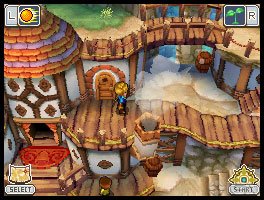
The game takes place 30 years after the end of Golden Sun: The Lost Age, at the end of which Alchemy had been restored to the world of Weyard via the tumultuous Golden Sun event. The lands have been rearranged and changed by the chaos, and new nations have been founded throughout the continents of the world, while all manner of ancient ruins and technology have been unearthed in various locations.
The eight controversial heroes that changed the world, now known across the world as the Warriors of Vale, have taken it upon themselves to have the responsibility of watching over and guarding the world and now live separately from each other. Several are known to have children, which they train as Adepts so that their children may one day watch the world in their stead. Isaac and Jenna married and have a son named Matthew, a Venus Adept. Garet has a Mars Adept son named Tyrell, Ivan has a Jupiter Adept daughter named Karis, and Mia has two Mercury Adept children named Rief and Nowell. Isaac, Garet, Matthew, and Tyrell live at Lookout Cabin, which Isaac constructed to overlook the still-erupting Mt. Aleph, while Ivan and Jenna live in Kalay. Mia lives in Imil, Sheba presumably lives in Lalivero, Piers now sails the world's seas investigating mysterious phenomena, and Felix left his home and has not been seen since. Kraden is still alive and traveling the world, despite being over a hundred years of age, because he and the Warriors of Vale all received extended lifespans when they were bathed in the energy at the aerie of the Mars Lighthouse.
Gameplay Features
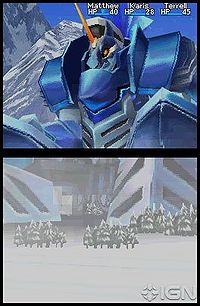
The game features a world with 3D environments and entirely 3D battles, and it features optional touch-screen stylus control. Stylus control is an additional way of controlling the functions that can otherwise be handled with the base control scheme from previous games, with touchable icons on screen that quickly and easily select and use Psynergy shortcuts.
The game features an encyclopedia system designed to tell players history of the world (including information about the previous games), and explain plot and character elements occurring in the present. As characters talk, specific text will highlight with hyperlinks, and if the player taps on the text with the stylus, that term's page from the encyclopedia will open up on the upper screen to fill players in on the details. If the page has already been read beforehand, the hyperlink will remain, but in a darkened color.
Eight all-new playable characters comprise the eventual final party, and unlike in previous games where there would be four characters at first and then suddenly jump up to eight, the full party is assembled at a steady rate as the game progresses. Characters are more-or-less similar in battle to previous games, but one of the characters, Sveta, has an entirely different battle style in which she transforms between humanoid and werewolf forms, where even her Attack and Defend commands are altered. Once again, there are 72 Djinn to collect, 18 for each element and therefore 9 for allocation to each of the eight playable characters; however, there are new Djinn introduced, and Djinn that are missing from the previous games. Some of these Djinn are present on adult Isaac and Garet, who join battles as uncontrolled "guest" characters in the beginning stages of the game. The system was also altered to allow each Djinni to have a unique design to differentiate it from all other Djinn of the same element.
The Class system is very similar to the original games in terms of how Djinn influence them, but in accordance with the new characters there are four new mono-element classes and two new dual-element classes, and some of the existing classes have been slightly retooled, such as with the Wind Seer series now having its own party-healing Psynergy. Classes provided by Class-changing items like in The Lost Age no longer exist, however.
All 29 Summon spirits from the Game Boy Advance titles return in Dark Dawn, redesigned for 3D presentation, with a few being changed more drastically, such as Boreas. One all-new summon, a Venus-aligned summon named Crystallux, was added, and appears identical to the chandelier in the "Culture Advanced" commercial for the original Golden Sun. This makes for a total of an even 30, and like in The Lost Age, the party starts out with access to the "initial 16" and must collect the other 14 by finding their Summon Tablets in the game world. Djinn that are on Standby now wander around the top screen of the DS in 2D while the battle takes place in 3D below. When a summon is used, the appropriate amount of Djinn will be removed from the top screen.
Psynergy old and new make fully 3D appearances as well, such as the Move Psynergy which is used to shift objects around. Growth, is now inherent to Matthew regardless of class series (without its upgraded forms, mad Growth and Wild Growth), so that he can use it as a utility Psynergy effect without having to constantly change classes, as was required in the original games.
Items and their categories are similar to the previous games, but with several important changes and additions. Staffs have been divided into Staffs and Ankhs, the latter of which is a more restricted sub-category. Bows are introduced as an all-new weapon type and Sveta uses her own category of weapons called Claws. Defensive equipment on the whole is less changed, though Shirts have been removed as supplementary equipment, while Rings have more of an emphasis on increasing stats, where before they had been almost solely about being usable items. Every weapon in the game has its own, unique 3D model that appears held by a character during battle. All weapons have Unleash effects, and most have multiple unleashes. Weapons will unlock unleashes when the character gains experience with the weapons in battle in a new weapon-experience system. Unleashes themselves have a wider array of effects as well, such as being able to hit all enemies on the battlefield at once.
Battle is very similar to the previous games, in that a party of four characters fights an enemy group, reserve party members may be switched in once per turn, and when the first party is all downed, the reserve party jumps in. Perhaps the most critical change is that when a character is set to attack an enemy, but another character has defeated that enemy beforehand in the same turn, the character will no longer automatically Defend; their attack will be redirected to another enemy on the battlefield.
There is no connectivity with Golden Sun: The Lost Age, even though GBA games can be inserted in the GBA slot of older DS systems. Furthermore, there is no Easy Mode or Hard Mode to replay the game with.
Walkthrough
See the condensed, spoiler-free walkthrough for a "perfect" rundown of the game's progression and secrets in a general overview style.
Tricks and Secrets
See the full list of glitches, tricks, and secrets here.
Development
Originally shown as "Golden Sun DS," the game was revealed to have the subtitle "Dark Dawn" on June 15, 2010. The Takahashi Brothers describe this subtitle as "core to the story" and that it will become relevant and understandable as the story goes on, but they said that because "Dark" and "Dawn" are essentially opposites, it can be thought of as "darkness and light, destruction and revival." On July 14, 2010, Japanese magzine Weekly Shōnen Jump announced the Japanese subtitle "漆黒なる夜明け" with character designs of Matthew, Tyrell and Karis. On July 22, During a Famitsu interview with the Takahashi brothers, Hiroyuki said that the two predecessors were "prologues" in the series, and that this comprised the real event that was to come.
On August 18, 2010, the official Japanese website was launched. An August 30, 2010 press release describes the premise like so: "Taking place 30 years after the events of Golden Sun and Golden Sun: The Lost Age for the Game Boy™ Advance system, Golden Sun: Dark Dawn introduces a new generation of heroes that are struggling to survive in a radically changed world. What begins as a simple journey to rescue a lost friend turns into a dramatic quest to save the land from catastrophe as players are drawn into a world full of magical energy." On September 2, 2010, the japanese website announced the game would publish on October 28, 2010.
Release
The Japanese release of Dark Dawn was on October 28, 2010 and sold 46,516 copies in first four days. It was released in North America on November 29, 2010, where it quickly sold 60,323 copies during the first week of it's release.
Also released in Japan was a promotional package titled Golden Sun: Dark Dawn - Adept's Navigation Guide, billed as a "magazine book". It features the following information:
- Character analysis files
- Introductions to locations via setting design showcases
- Story explanation of past and present events
- Game system explanations, such as Psynergy, Djinn, and Summon
- A map-based walkthrough of the full game, with marked chest, Djinn, and Summon locations
- Lots of data concerning Items, Classes, Djinn, Summons, etc.
In addition, two bonus products came with the package: An OST soundtrack CD of Dark Dawn music, and a special Dark Dawn manga appearing in V-Jump December 2010, illustrated by Higashimoto Kazuki. It depicts the main characters setting off on their journey and engaging in heated battles with adversaries. Includes a signed autograph on colored paper.
Dark Dawn was released in Australia on December 2, 2010 and then in Europe on December 10, 2010.
As of January 1, 2012, the game has sold 80,886 copies in Japan. It may be worth noting that the game had more sales in North America than it did in Japan and Europe combined, a rare occurrence for a game not created in North America.
Reception
On October 20, 2010, Japanese gaming magazine Famitsu scored the game 33/40 praising the game's graphics, sound, puzzle elements, and balance, while citing the lack of innovation, characters who show empathy, and some puzzles that were too complex as reasons for a lower score. It should be noted that Famitsu gave the two previous games similar scores, marking Dark Dawn as on par with it's predecessors.
Golden Sun: Dark Dawn had mixed reviews from critics. It is ranked at 79% on Metacritic and 80% on GameRankings. The game was not as well received as its predecessors: Golden Sun received a 91% and a 90% on Metacritic and GameRankings respectively, while The Lost Age received an 86% and an 87%. Edge awarded the game an 8/10 stating that "despite its lack of teeth... Golden Sun remains a franchise with plenty to say."
Reviews generally praise the game's 3D graphics, Djinn system, and puzzles. However, they complain that battles are too easy and that the dialogue scenes are too long. Some reviewers thought that the encyclopedia system was extremely friendly for new players, while others thought that the new emotion system was superfluous.
Gallery
Official promotional art of Matthew
Official promotional art of Karis
Official promotional art of Tyrell
Official promotional art of Rief
Official promotional art of Amiti
Official promotional art of Sveta
Official promotional art of Eoleo
Official promotional art of Himi
Official promotional art of Isaac
Official promotional art of Kraden
Official promotional art of Blados
Official promotional art of Chalis
Official promotional art of Arcanus
Matthew at Patcher's Place.
Matthew at Konpa Ruins.
Matthew walking through Patcher's Place, with a Mars Djinni "Forge" visible above.
Atalanta summon sequence
Offical art of Isaac's Lookout Cabin
Official art of Patcher's Place
Official art of Goma Plateau
Unused promo art of a battle against a Curse Demon
Trivia
- The August 2009 issue of the U.K.-circulated Official Nintendo Magazine made the erroneous claim that the main playable character seen in the E3 trailer, later known as Matthew, was Isaac himself, rather than a descendant of Isaac as confirmed by the E3 press release. [2] Nintendo Power reported him to be Isaac's son beforehand.
- At the end of Dark Dawn, the screen shown "The End ...?" in American games, but in the Japanese version, the screen only displays "The End" without the ellipsis and question mark.
External Links
| Golden Sun games and media | |
|---|---|
| Main Series Games | Golden Sun • Golden Sun: The Lost Age • Golden Sun: Dark Dawn |
| Cameos: | Super Smash Bros. Brawl & Ultimate |
| Other Media: | 4-Koma Gag Battle • Dark Dawn V-Jump manga |
| Other Information: | Game data directory • GBA plot summary • Dark Dawn plot summary • Staff Credits |
